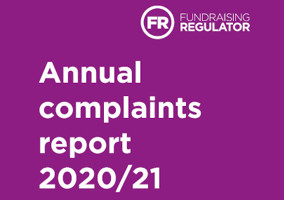Recently the Fundraising Regulator published its hotly-anticipated annual analysis of complaints. It is a thorough and detailed report, with the potential to help fundraisers make better informed decisions, so it is important for everyone in the sector to learn the right lessons from the findings.
The research covers both complaints made to the regulator and a survey of large charities about the complaints reported directly to them.
This offers a fascinating insight into what has irritated people about the fundraising techniques of the largest household-name charities, whose activity accounts for most organised fundraising, as well as data based on the regulator’s own activities.
There is an obvious is a correlation between levels of fundraising activity and the volume of complaints, as many charities point out in their annual statements about fundraising complaints. So, in a year where much in-person fundraising, was on hold to mitigate the spread of coronavirus, it is not surprising that there has been some fluctuation in the findings.
At the same time, there are also some clear trends around what frustrates the public, regardless of lockdowns and pandemics, which can be a helpful resource for fundraising leaders and trustees when considering what activities to pursue.
However, leaders must remember that complaints, or potential complaints, are only one factor to consider when developing a fundraising strategy. Just replacing door-to-door fundraising with newspaper adverts may feel less risky and reduce the number of complaints, but it might also raise less money.
More complaints about digital
Every year, the regulator surveys the 56 largest fundraising charities about the types of complaints they have dealt with in the year to 31 March.
While this is not a representative sample of all charities, it does give a good general indication of the types of fundraising that prompted people to complain.
As charities pivoted to digital, so did complaints, and complaints about online fundraising increased by 357% to 5,836.
This sounds worrying, but when set in the context of increased activity, it feels less of a problem. Even the regulator does not seem to be unduly alarmed, having estimated that just one impression in nearly two million received a complaint.
Nonetheless, the regulator has urged charities to consider best practice as online fundraising methods evolved and said it would do some work over the next year to help both fundraisers and the public understand what to expect.
On the other hand, complaints about social events fell by 300% to 375. Similarly, complaints about static collections and door-to-door activity also fell significantly.
There are other, slightly less dramatic, shifts in the things that people complained about.
Complaints about television adverts nearly doubled, from 430 to 715. As with the increase in online, this could reflect the increase in fundraising activity during the pandemic, with more charities using this channel, but it could also be because more people were watching television when there was little else to do during lockdown.
What else annoys people?
Still, looking at the other data reported by large charities to the regulator, the trend seems to be that the more intrusive and widespread the fundraising method is the more complaints it attracts.
For example, addressed mail is still the second most complained about method, although complaints fell for the second consecutive year.
And even though the volume of complaints about door-to-door fundraising fell significantly, it was still the fifth most-complained about activity.
It’s human nature to bristle when something encroaches on your territory or home that makes you uncomfortable. It is natural to respond defensively, or hit back by making a complaint to the charity involved.
This is why charities must continually think about the training they provide fundraisers and use all the tools at their disposal to make sure approaches are made in a sensitive and respectful way.
Another reason to pay attention to complaints is that they can alert charities to fraudulent activity.
“A few charities did report to us that they received complaints in relation to door-to-door activity which they considered to be fraudulent as the charity had not undertaken any door-to-door fundraising in that area,” the report notes.
At the bottom of the complaints league table are things such as print media, public outdoor advertising and radio advertising.
These types of fundraising are not targeted at individuals and, as a member of the public, easy enough to ignore. This is good if you want to keep complaints low, but maybe not so good if it’s an urgent appeal for a natural disaster.
Trust and major donor fundraising also seem to attract very few complaints. Perhaps because in most cases these people are expecting to be approached by charities seeking funding.
Understanding still poor
Turning to the part of the report that deals with complaints made directly to the Fundraising Regulator, the biggest takeaway is that fundraising and its regulation are still poorly understood by the general public.
Firstly, the volume of complaints is still small – just 907. More worryingly, well under half (363) of the complaints were classed as “in-remit”. This means that the regulator was acting as a conduit to others such as the Charity Commission or Action Fraud.
Complaints about organisations that are not even registered with the regulator are also a factor.
“Around 40% of incoming complaints were about registered organisations over the past two years. Looking closer at the non-registrant data, many of these complaints do not concern charities or third-party fundraisers. Instead, they concern individuals carrying out ‘in-aid-of fundraising’, crowdfunding or are out of remit (i.e. are not about fundraising at all),” the report explains.
Secondly, very few complaints that were in-remit progress to a regulatory investigation. In 2020-21, 13 investigations were completed. However, where the regulator does investigate it finds a breach of the Code of Fundraising Practice in most cases (69%).
Furthermore, when the regulator finds a breach of the code it is not always related to the original complaint.
Finally, the take up of the Fundraising Preference Service (FPS), is still low. During 2020-21, just 722 charities received requests via the tool that lets people inform multiple charities they would like to cease contact.
Indeed, a review of the service last year warned that use of the service is declining, with just 30 members of the public a week using the service. Those fundraisers who have long argued that the FPS is a waste of time and money, are unlikely to be swayed by these latest findings.
Just as charities should use the findings of this report to help inform their future plans, the regulator should also consider how it should use this knowledge as it develops its next five-year strategy for 2022 onwards.
Related articles












